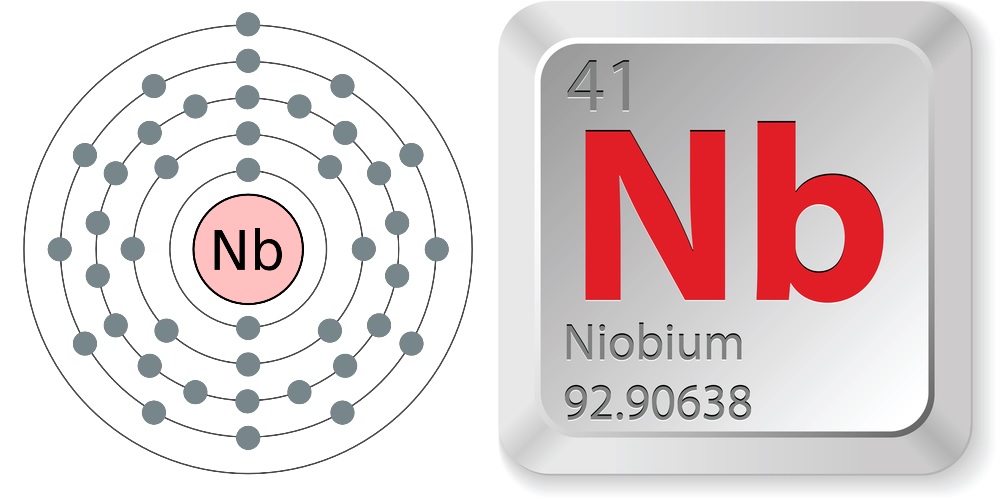Facts About Niobium

Niobium is a shiny, white metal that typically forms a film on its surface when exposed to air, turning shades of blue, green, or yellow, according to Chemicool. It has a wide range of uses from use in hypoallergenic jewelry to jet engines to superconducting magnets.
Just the facts
- Atomic number (number of protons in the nucleus): 41
- Atomic symbol (on the periodic table of elements): Nb
- Atomic weight (average mass of the atom): 92.906
- Density: 8.57 grams per cubic centimeter
- Phase at room temperature: Solid
- Melting point: 4,491 degrees Fahrenheit (2,477 degrees Celsius)
- Boiling point: 8,571 degrees F (4,744 degrees C)
- Number of isotopes (atoms of the same element with a different number of neutrons): 35
- Most common isotopes: Nb-93 (100 percent natural abundance)
History
Niobium has a convoluted history. John Winthrop discovered an ore in Massachusetts in 1734 and sent it to England. The mineral sat in the British Museum collection for years until it was analyzed in 1801 by Charles Hatchett. He discovered a new element in the ore and named it columbium after Columbia, the poetic name for America. In 1809, William Hyde Wollaston, an English chemist compared columbite with another mineral, tantalite, and declared that columbium was actually the element tantalum. The two elements are very similar, are always found together and are difficult to isolate.
In 1844, Heinrich Rose, working with samples of columbite and tantalite, produced two new separate, but very similar, acids, which he named niobic acid and pelopic acid. He renamed the element niobium. Twenty years later, Swiss chemist Jean Charles Galissard de Marignac isolated metallic niobium by heating the chloride in a hydrogen atmosphere.
The element was called columbium (symbol Cb) in the United States for about 100 years, while it was called niobium in Europe. In 1949, the International Union of Pure and Applied Chemistry compromised and officially adopted niobium as the element's name, in deference to European usage. In turn, the union accepted tungsten rather than wolfram as the name for Element No. 74 (which still carries the symbol W), in deference to American usage. Many metallurgists and metal societies, however, still refer to niobium as columbium.
Who knew?
- Niobium is named for the Greek goddess of tears, Niobe, who was the daughter of king Tantalus, according to the Royal Society of Chemistry, due to the element's similarities to tantalum (named for the king).
- Niobium and tantalum are nearly always found together in nature, according to the U.S. Geological Survey (USGS).
- The International Union of Pure and Applied Chemistry officially adopted the name niobium in 1950, according to Los Alamos National Laboratory. However, the element's other name, columbium, is still widely used today.
- According to the USGS, nearly all niobium is mined in Brazil and Canada. The estimated amount of niobium in the Earth's crust is thought to last for the next five centuries.
- According to Lenntech, while some compounds of niobium dust can cause eye and skin irritation, there are no known cases of any serious effects of working with niobium. There are also no known environmental effects of niobium.
- According to USGS, nearly 80 percent of niobium is used in the steel industry to create high-strength low-alloy steels. The use of niobium in these alloys increases the steels' mechanical and high-temperature strength, toughness, and corrosion resistance.
- Other uses of niobium, according to Chemicool, include pipeline construction, superalloys for heat resistant equipment including jet engines, and in jewelry.
- Niobium, tungsten, molybdenum, tantalum and rhenium are known as the five refractory metals, according to Chemicool. These metals all have very high resistance to heat and wear.
Current research
Niobium, due to its variety of properties, is used in several areas of research. One such research is in creating magnets. One of the strongest superconducting magnets in the world uses niobium alloy wires, such as niobium-tin and niobium-titanium, according to National High Magnetic Field Laboratory. The 2.3-ton magnet is made of coils of three types of wire, two with niobium, and reaches field strengths of 32 teslas (the strength of Earth's magnetic field on the surface of the planet ranges from 30 to just over 60 microteslas or 30x10-6 to 60x10-6 teslas).
One such use for a superconducting magnet is in magnetic resonance imaging (MRI) or spectroscopy (MRS), according to a 2018 patent. The superconducting magnet uses niobium-titanium wire coils to create an initial magnetic field and additional coils of niobium-tin wire to create a secondary magnetic field. The two fields combine to create a stronger magnetic field that the more traditional niobium-titanium superconducting magnet.
Get the world’s most fascinating discoveries delivered straight to your inbox.

Rachel Ross is a science writer and editor focusing on astronomy, Earth science, physical science and math. She holds a Bachelor of Arts in Philosophy from the University of California Davis and a Master's degree in astronomy from James Cook University. She also has a certificate in science writing from Stanford University. Prior to becoming a science writer, Rachel worked at the Las Cumbres Observatory in California, where she specialized in education and outreach, supplemented with science research and telescope operations. While studying for her undergraduate degree, Rachel also taught an introduction to astronomy lab and worked with a research astronomer.



